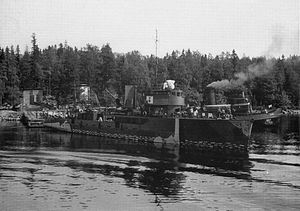Finnish minelayer Riilahti
This article needs additional citations for verification. (March 2015) |
 Riilahti in 1942
| |
| History | |
|---|---|
| Name | Riilahti |
| Namesake | Battle of Riilahti (1714) |
| Builder | Wärtsilä Crichton-Vulcan |
| Launched | 14 December 1940 |
| Fate | Torpedoed and sunk 23 August 1943 |
| General characteristics | |
| Class and type | Ruotsinsalmi-class |
| Displacement | 310 t |
| Length | 50.0 m (164.0 ft) |
| Beam | 7.9 m (26 ft) |
| Draught | 1.5 m (4 ft 11 in) |
| Propulsion |
|
| Speed | 15 knots (28 km/h; 17 mph) |
| Armament |
|
Riilahti was a
Funding for two new minelayers had been secured as early as in 1937, but instead the money was used to refurbish the garrison at Mäkiluoto. Riilahti was launched on December 14, 1940, three weeks after her sister ship Ruotsinsalmi.
The ship had an extensively modified propulsion system and hull, compared to her sister vessel, and it took some time before the crew had figured out all the characteristics of the vessel. Originally, the vessels were intended as escort
Riilahti was commanded by kapteeniluutnantti Osmo Kivilinna during her entire career.
Riilahti during the Continuation War
Riilahti and Ruotsinsalmi began mining the
In 1941, Riilahti managed to seize control of a Soviet barge and participated in minesweeping operations south of the Hanko Peninsula.
In the summer of 1942, Riilahti laid numerous mines near
Riilahti was sent as reinforcement to the island of
The Marshal of Finland,
The last battle
On August 22, 1943 at 5.30 am, Riilahti set out from
This was one of the most significant single losses during the war years; Kivinlinna was a very well-liked officer, and it was widely believed that he could become the first full Admiral of the Finnish Navy.
The wreck of Riilahti lies five nautical miles from the island of Tiiskeri[2] at a depth of 70 m. The loss of Riilahti left the Finnish Navy with a gap in their mine warfare capabilities. This was addressed with the launching of the Keihässalmi in 1957.
The third engine, which had been ordered, but not yet fitted on the Riilahti was instead fitted onto the sister vessel Ruotsinsalmi.
Riilahti laid 1,733 sea mines and 599 obstacles during her career.
References
- ^ "Finnish navy in Continuation War, year 1943". Archived from the original on 2014-12-21. Retrieved 2015-02-12.
- ^ "Riilahti Minelayer 1940-1943". Wrecksite. Retrieved 28 September 2023.
